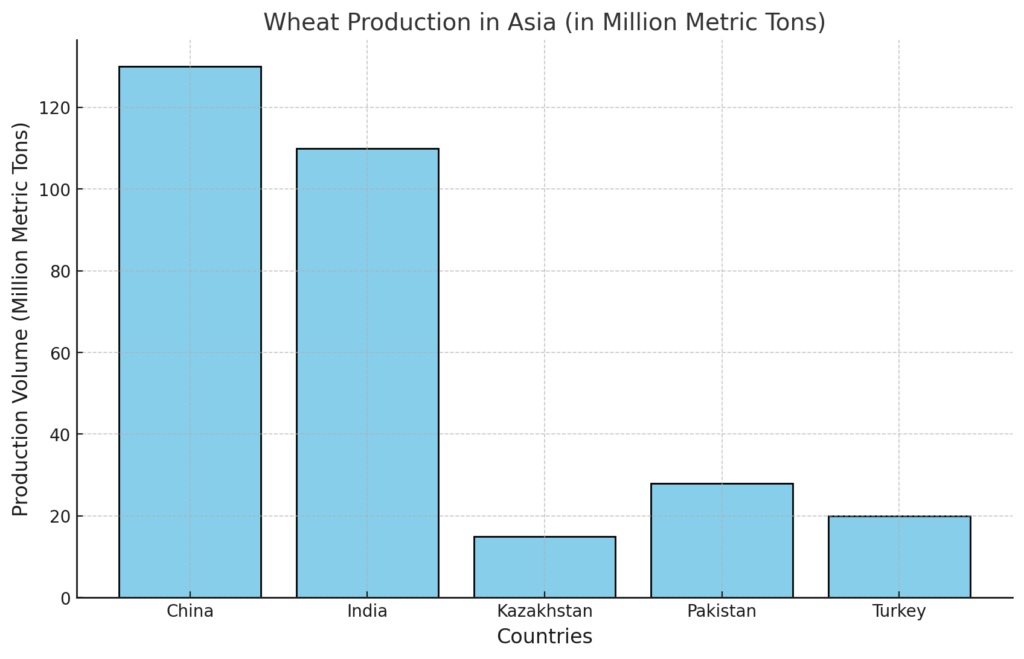
Asia is a powerhouse in wheat production, contributing significantly to the global supply. With vast agricultural lands and a history rooted in farming, Asian countries have become vital players in the wheat market. This article explores the top wheat producers in Asia and their impact on the global agricultural economy.

1. China: The Dominant Force
China leads the continent in wheat production, accounting for approximately 20% of global output. The country’s extensive farmlands and government-backed agricultural initiatives contribute to its robust wheat industry.
Key Highlights:
- Production Volume: Over 130 million metric tons annually.
- Major Regions: Henan, Shandong, and Hebei provinces.
- Government Support: Subsidies and modernization programs enhance productivity.
China’s focus on self-sufficiency in staple crops ensures its position as a global leader in wheat production.
2. India: A Rising Wheat Giant
India is the second-largest wheat producer in Asia and a significant contributor to global exports. The fertile plains of the Indo-Gangetic region are the backbone of its wheat cultivation.
Key Highlights:
- Production Volume: Approximately 110 million metric tons annually.
- Major States: Uttar Pradesh, Punjab, and Haryana.
- Export Markets: Neighboring countries and regions in the Middle East.
The Indian government supports its farmers through minimum support prices and export incentives, ensuring steady growth in production.
3. Kazakhstan: The Export-Oriented Player
Kazakhstan, known for its vast steppes, is a major wheat producer and exporter. Its wheat is highly sought after for its superior quality.
Key Highlights:
- Production Volume: Around 14-15 million metric tons annually.
- Export Focus: Central Asia, Europe, and China.
- Unique Advantage: High-quality, hard wheat varieties.
Kazakhstan’s strategic location and efficient export channels make it a crucial supplier in global markets.
4. Pakistan: Meeting Domestic and Regional Demand
Pakistan ranks among Asia’s top wheat producers, with its agriculture-driven economy heavily reliant on wheat as a staple crop.
Key Highlights:
- Production Volume: Approximately 27-28 million metric tons annually.
- Cultivation Areas: Punjab and Sindh provinces.
- Challenges: Water scarcity and reliance on traditional farming methods.
Despite challenges, Pakistan’s wheat sector remains resilient, catering to domestic needs and exporting to neighboring countries.
5. Turkey: Bridging Asia and Europe
Turkey, straddling two continents, plays a unique role in wheat production. While not the largest in Asia, it is a significant producer in the region.
Key Highlights:
- Production Volume: Around 20 million metric tons annually.
- Key Regions: Central Anatolia and Thrace.
- Export Markets: Middle East, North Africa, and Europe.
Turkey’s strategic location and modern agricultural practices contribute to its position as a leading wheat producer.
Factors Driving Wheat Production in Asia
- Technological Advancements: Mechanization and improved irrigation systems boost yields.
- Favorable Climate: Diverse climates across Asia allow for year-round cultivation.
- Government Policies: Subsidies, research, and support programs enhance productivity.
Challenges Faced by Asian Wheat Producers
- Climate Change: Unpredictable weather patterns affect crop yields.
- Water Scarcity: Overreliance on groundwater poses sustainability issues.
- Trade Barriers: Geopolitical tensions impact export markets.
Conclusion
The largest wheat producers in Asia—China, India, Kazakhstan, Pakistan, and Turkey—play pivotal roles in ensuring food security and driving the global wheat market. As these nations continue to innovate and adapt to challenges, their influence in the agricultural sector is set to grow further.



